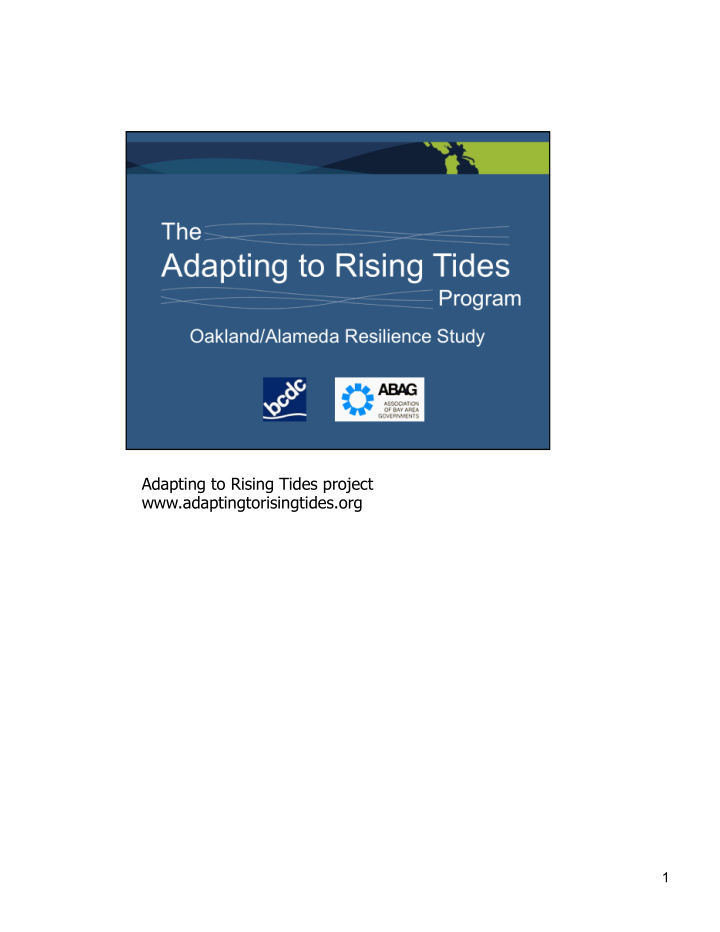



Adapting to Rising Tides project www.adaptingtorisingtides.org 1
The ART program is leading, collaborating on, or supporting a number of related projects. 2
3
Last meeting was November 14, 2013. In that meeting, we introduced the two projects that form the background of this one, and discussed how those projects would be linked and scaled down to the Oakland / Alameda focus area. We also introduced the adaptation planning process that will be followed for this project. 4
In the last meeting, we went through the Scope & Organize step. We have some follow-up on two elements: assets and resilience goals 5
First, some updates on what the team has been working on since the November meeting. 6
We have been revising our asset list since last meeting, based on suggestions from working group members and developing a 'tiered' approach to how we plan to conduct V&R assessment. Seeking to answer neighborhood scale questions; doing more detailed assessments than at the subregional scale, but not necessarily doing full assessments of every single asset in the focus area. Complex, locally or regionally significant, or networked assets will be analyzed in detail, while less complex, non-networked, or very numerous assets (e.g., schools) may be analyzed in less detail – we may do a general analysis, look at a few representative assets, or take assets up later as we learn more about their neighborhood. For the assets in the latter category, our assessments will evolve organically; there isn't a firm cutoff where we won't consider any more in greater detail, and if we learn something while analyzing another asset that indicates we need to take a closer look, we will do so. Some assets may get more attention during the Plan step when we're considering adaptation responses, as we may find that a response would affect an asset that wasn't previously analyzed in detail. We will put up a revised list of assets on the website soon for review, and we'll keep you posted in meetings going forward if there are any major changes to the assets we're examining. 7
These are the draft goals for this process - you should be able to see your own agency’s mission in the goal but some parts of it/ them may be tangential to your goals. Goals can be specific or broad, near or long term. 8
Summary list of concepts that came up in lightning round in last meeting, organized under the 4 frames 9
10
Draft resilience goals developed by BCDC and ABAG – any suggested revisions? 11
The rest of this meeting will focus on the Assess Step. 12
The Assess step includes assessing existing conditions, identifying vulnerabilities (which can be thought of as exposure, sensitivity, and adaptive capacity), and determining risks (in the case of the ART project, risk focused on the consequences of an impact occurring for the economy, environment, society, and governance structures.) 13
This project will use a set of questions – or metrics – to identify vulnerabilities and risks for the various assets. These questions address existing conditions; four types (‘classifications’) of vulnerabilities, identified during the subregional project, and consequences for society and equity, environment, and economy. 14
15
16
17
18
19
20
BCDC and ABAG staff have begun gathering vulnerability and risk information for assets in the OAK/ALA focus area. They are using information found in the subregional study and ABAG’s Airport and Infrastructure Resilience Project, and other publicly available information. Will need help from the working group to fill in gaps! The metrics tool looks like this. 21
Once the metrics are filled in for each asset, we will create a profile sheet, which summarizes the findings from the metrics. The profile sheet forms the base for developing adaptation responses and also serves as a communication tool. The 2 nd page is most helpful in developing responses – by identifying types of vulnerabilities, it makes it easier to figure out what kinds of solutions would best address those vulnerabilities. The 1 st page is more useful as a communication tool – it introduces the asset and synthesizes the vulnerabilities and risks so the reader can tell, at a glance, what the major issues are. 22
Map for breakout session – see handout. 23
24
25
Recommend
More recommend